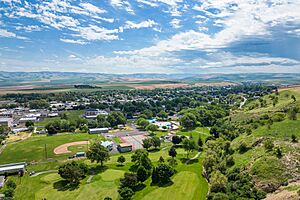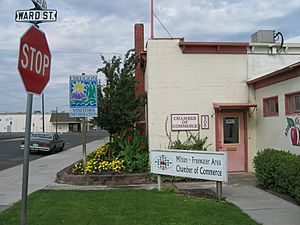Milton-Freewater, Oregon facts for kids
Quick facts for kids
Milton-Freewater, Oregon
|
|
|---|---|

Looking southeast over the city from Milton-Freewater Golf Course
|
|
| Nickname(s):
Muddy Frogwater Country
|
|

Location in Oregon
|
|
| Country | United States |
| State | Oregon |
| County | Umatilla |
| Incorporated | 1950 |
| Area | |
| • Total | 2.03 sq mi (5.26 km2) |
| • Land | 2.03 sq mi (5.26 km2) |
| • Water | 0.00 sq mi (0.00 km2) |
| Elevation | 1,037 ft (316 m) |
| Population
(2020)
|
|
| • Total | 7,151 |
| • Density | 3,524.40/sq mi (1,360.67/km2) |
| Time zone | UTC-8 (Pacific) |
| • Summer (DST) | UTC-7 (Pacific) |
| ZIP code |
97862
|
| Area code(s) | 458 and 541 |
| FIPS code | 41-48600 |
| GNIS feature ID | 2411115 |
| Website | www.mfcity.com |
Milton-Freewater is a city in Umatilla County, Oregon, in the United States. It got its name in 1951. Before that, there were two separate towns: Milton and Freewater. They decided to join together.
In 2020, about 7,151 people lived there. Milton-Freewater is part of a larger area that includes Pendleton and Hermiston. The city is also becoming well-known for its growing wine industry.
Contents
History of Milton-Freewater
The area where Milton-Freewater now stands was first settled in 1868. The town of Milton was officially formed by 1873. No one is quite sure how Milton got its name. It might have been named because people hoped to build a mill there. Or, it could have been named after the famous English poet, John Milton.
The town of Freewater was located right next to Milton, to the north. It got its name because new settlers were offered free water rights for their homes. Before this name was chosen, people thought about calling it New Walla Walla or Wallaette.
In 1936, a strong earthquake happened about 6 miles (10 km) away. It caused a lot of damage in Milton-Freewater and the surrounding areas. The earthquake also caused many smaller tremors afterwards. For a while, it even changed how much water was available underground.
Pea Capital to Muddy Frogwater
In the 1960s, Milton-Freewater was known as the "pea capital of the world." Many pea canneries operated in the town. They even had a yearly "Pea Festival" and parade in May.
However, by the late 1970s, farming methods changed. The prices for peas also changed. Because of this, peas were no longer grown as much in the area. One by one, the canneries closed down. The town stopped calling itself the "pea capital" and ended the festival.
At that time, Milton-Freewater also had a popular event in August called the "Corn Roast." The town decided to make this event bigger. In 1981, it became the "Muddy Frogwater Festival." The city had sometimes been called "Muddy-Frogwater" as a fun nickname.
Today, the Muddy Frogwater Festival is a three-day event held every third weekend in August. It includes fun activities like frog-jumping contests, concerts, and karaoke. There's also the traditional corn roast and a dance. Since 1993, the Friends of the Library have held a big outdoor book sale at the festival. On Sunday morning, there's an outdoor church service. The city has also placed more than 50 chainsaw sculpture frogs at local businesses. This helps promote the city as a "fun town" with a unique nickname.
Geography
Milton-Freewater covers a total area of about 1.99 square miles. All of this area is land.
Climate
Milton-Freewater has a steppe climate. This means it has dry summers and cold winters. It doesn't get a lot of rain.
| Climate data for Milton-Freewater, Oregon (1991–2020 normals, extremes 1928–present) | |||||||||||||
|---|---|---|---|---|---|---|---|---|---|---|---|---|---|
| Month | Jan | Feb | Mar | Apr | May | Jun | Jul | Aug | Sep | Oct | Nov | Dec | Year |
| Record high °F (°C) | 70 (21) |
78 (26) |
81 (27) |
90 (32) |
99 (37) |
114 (46) |
109 (43) |
111 (44) |
103 (39) |
92 (33) |
82 (28) |
71 (22) |
114 (46) |
| Mean daily maximum °F (°C) | 44.2 (6.8) |
48.6 (9.2) |
57.5 (14.2) |
64.7 (18.2) |
73.6 (23.1) |
80.5 (26.9) |
90.4 (32.4) |
89.3 (31.8) |
79.6 (26.4) |
65.8 (18.8) |
51.7 (10.9) |
43.5 (6.4) |
65.8 (18.8) |
| Daily mean °F (°C) | 37.2 (2.9) |
40.7 (4.8) |
48.1 (8.9) |
54.2 (12.3) |
62.0 (16.7) |
68.3 (20.2) |
76.7 (24.8) |
75.8 (24.3) |
67.1 (19.5) |
55.0 (12.8) |
43.6 (6.4) |
36.8 (2.7) |
55.5 (13.1) |
| Mean daily minimum °F (°C) | 30.3 (−0.9) |
32.8 (0.4) |
38.7 (3.7) |
43.7 (6.5) |
50.4 (10.2) |
56.0 (13.3) |
63.1 (17.3) |
62.3 (16.8) |
54.6 (12.6) |
44.3 (6.8) |
35.6 (2.0) |
30.1 (−1.1) |
45.2 (7.3) |
| Record low °F (°C) | −17 (−27) |
−17 (−27) |
6 (−14) |
15 (−9) |
25 (−4) |
38 (3) |
39 (4) |
40 (4) |
28 (−2) |
13 (−11) |
−12 (−24) |
−24 (−31) |
−24 (−31) |
| Average precipitation inches (mm) | 1.75 (44) |
1.52 (39) |
1.70 (43) |
1.62 (41) |
1.77 (45) |
1.25 (32) |
0.34 (8.6) |
0.39 (9.9) |
0.61 (15) |
1.22 (31) |
1.92 (49) |
2.06 (52) |
16.15 (410) |
| Average snowfall inches (cm) | 2.4 (6.1) |
1.3 (3.3) |
0.1 (0.25) |
0.0 (0.0) |
0.0 (0.0) |
0.0 (0.0) |
0.0 (0.0) |
0.0 (0.0) |
0.0 (0.0) |
0.0 (0.0) |
0.3 (0.76) |
3.1 (7.9) |
7.2 (18) |
| Average precipitation days (≥ 0.01 in) | 10.2 | 9.1 | 9.6 | 8.6 | 7.5 | 5.6 | 1.7 | 1.6 | 3.0 | 6.3 | 10.0 | 10.2 | 83.4 |
| Average snowy days (≥ 0.1 in) | 1.1 | 0.4 | 0.2 | 0.0 | 0.0 | 0.0 | 0.0 | 0.0 | 0.0 | 0.0 | 0.4 | 0.8 | 2.9 |
| Source: NOAA | |||||||||||||
Population Information
| Historical population | |||
|---|---|---|---|
| Census | Pop. | %± | |
| 1960 | 4,110 | — | |
| 1970 | 4,105 | −0.1% | |
| 1980 | 5,086 | 23.9% | |
| 1990 | 5,533 | 8.8% | |
| 2000 | 6,470 | 16.9% | |
| 2010 | 7,050 | 9.0% | |
| 2020 | 7,151 | 1.4% | |
| U.S. Decennial Census | |||
In 2010, Milton-Freewater had 7,050 people living in 2,479 homes. The city had about 3,543 people per square mile.
About 40% of the homes had children under 18 living there. Many homes (48.4%) were married couples. About 30% of the people living in the city were under 18 years old. The average age of people in Milton-Freewater was about 31.5 years.
The Rocks AVA Wine Region
The area around Milton-Freewater is famous for its wine. In February 2015, a special wine region was created here. It's called The Rocks District of Milton–Freewater American Viticultural Area (The Rocks AVA). An "AVA" is a special area recognized for growing grapes that make unique wines.
Education
Schools in Milton-Freewater are managed by the Milton-Freewater Unified School District. These schools include:
- McLoughlin High School
- Central Middle School
- Freewater Elementary
- Ferndale Elementary School
- Gib Olinger Elementary School
- Milton-Stateline Adventist School
Famous People
- George Flower, an actor, writer, and producer
- Oscar Harstad, a former major league baseball pitcher
Sister Cities
Milton-Freewater has a "sister city" in another country. This means they share a special friendship and cultural exchange.
See also
 In Spanish: Milton-Freewater para niños
In Spanish: Milton-Freewater para niños


